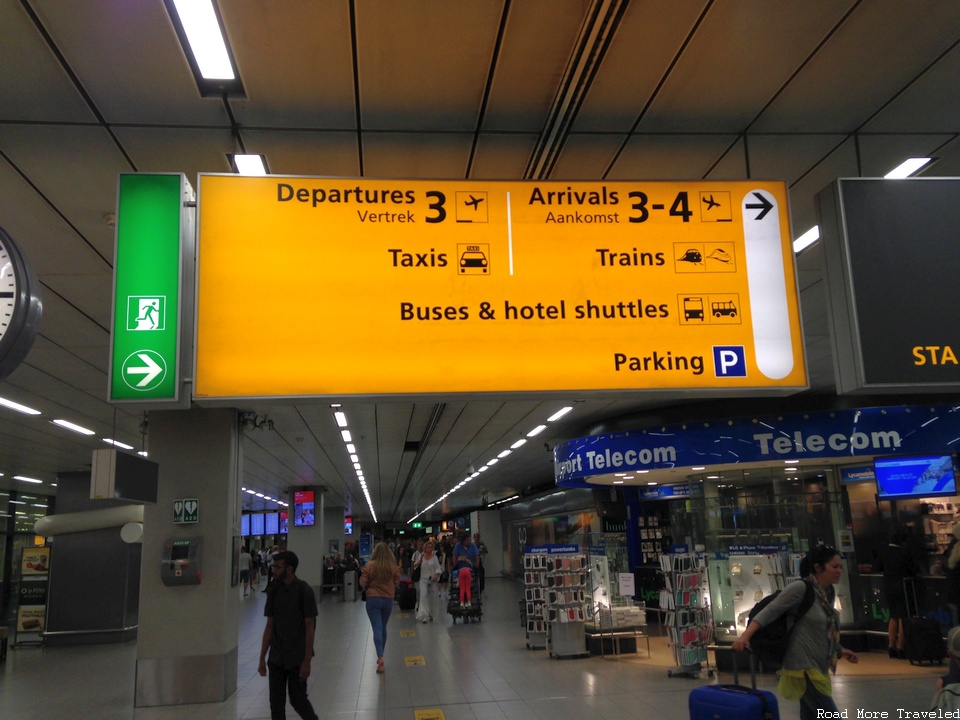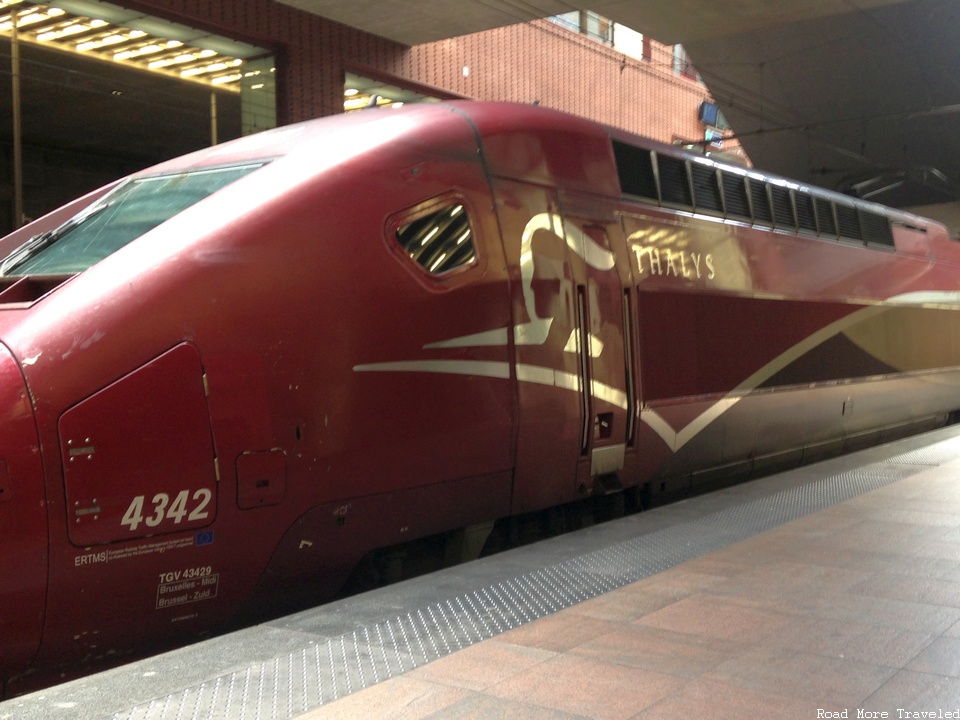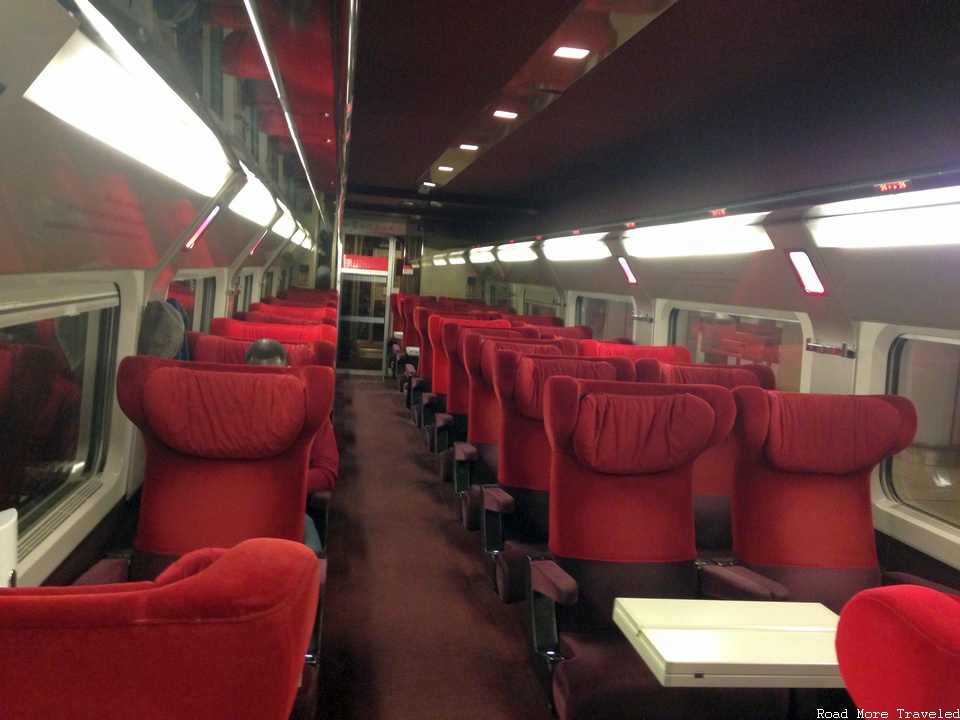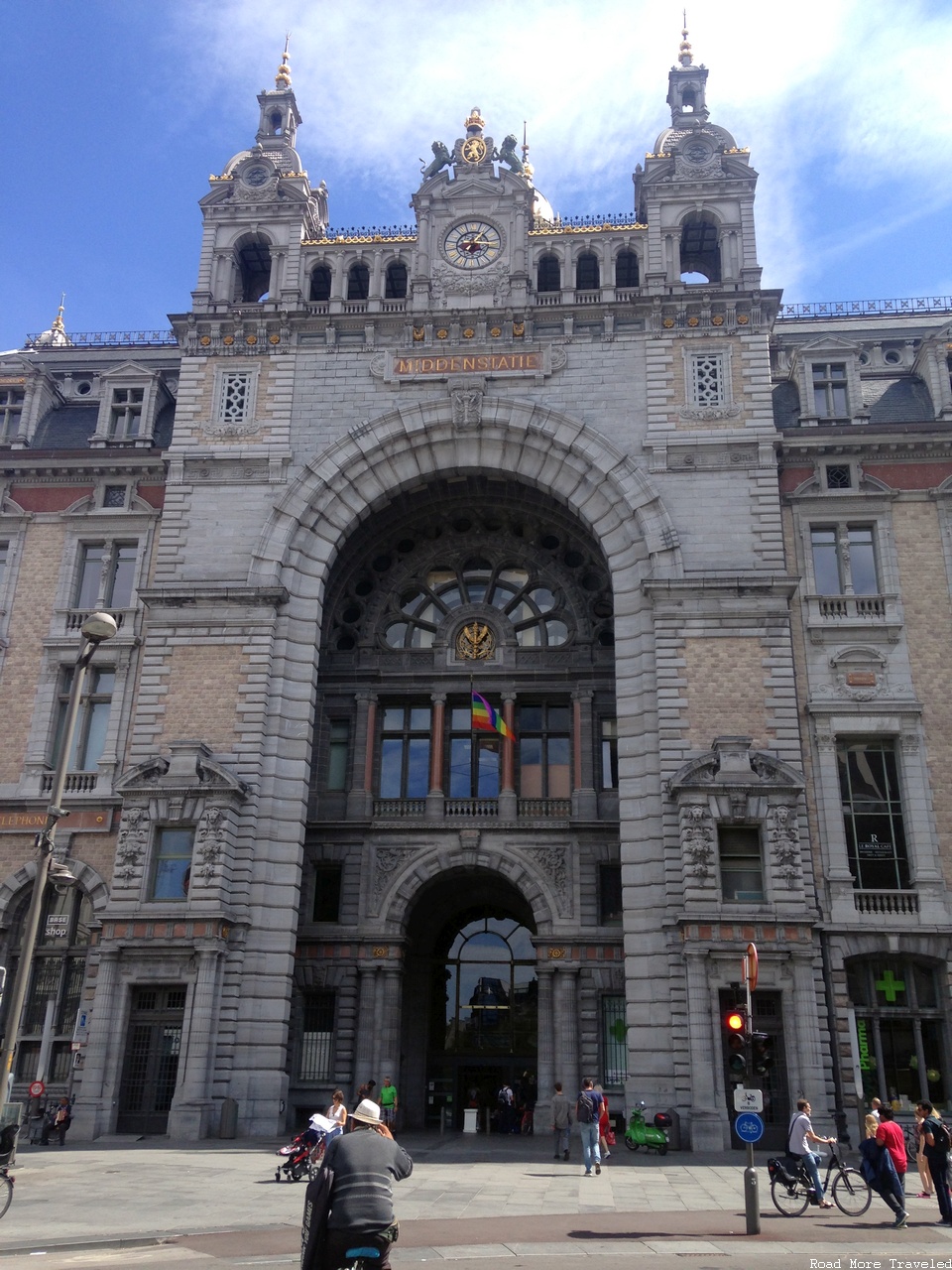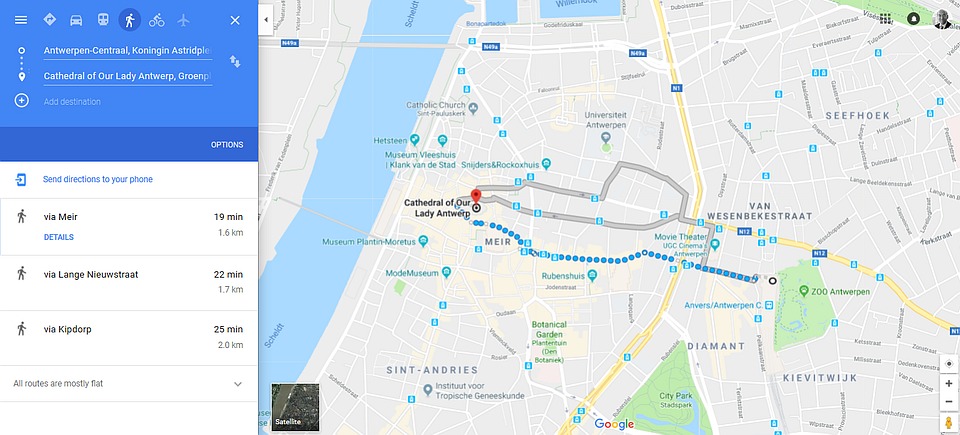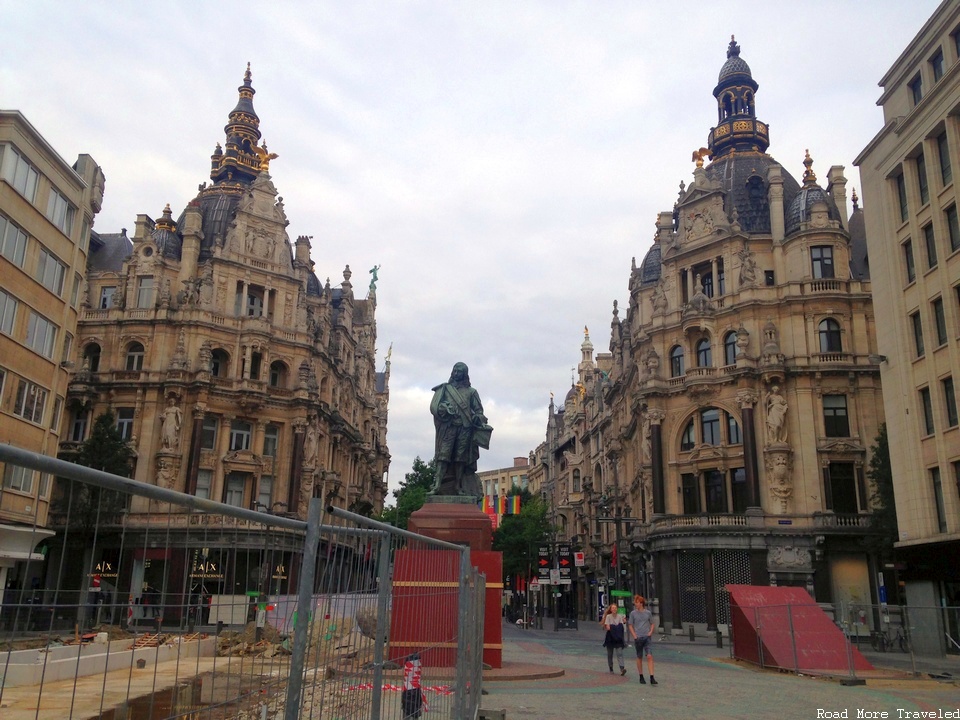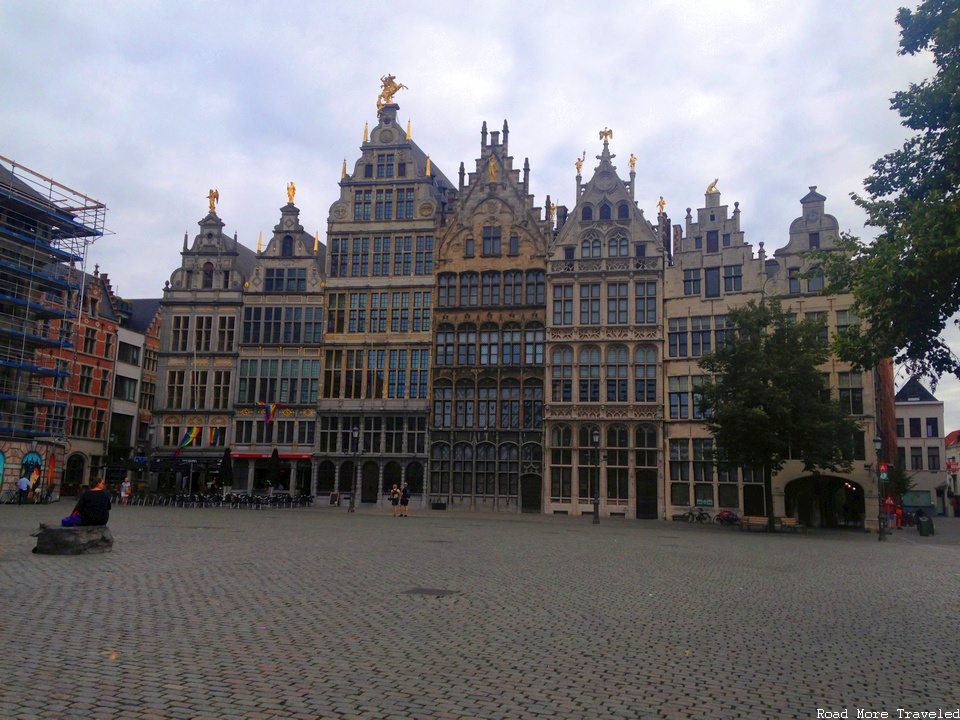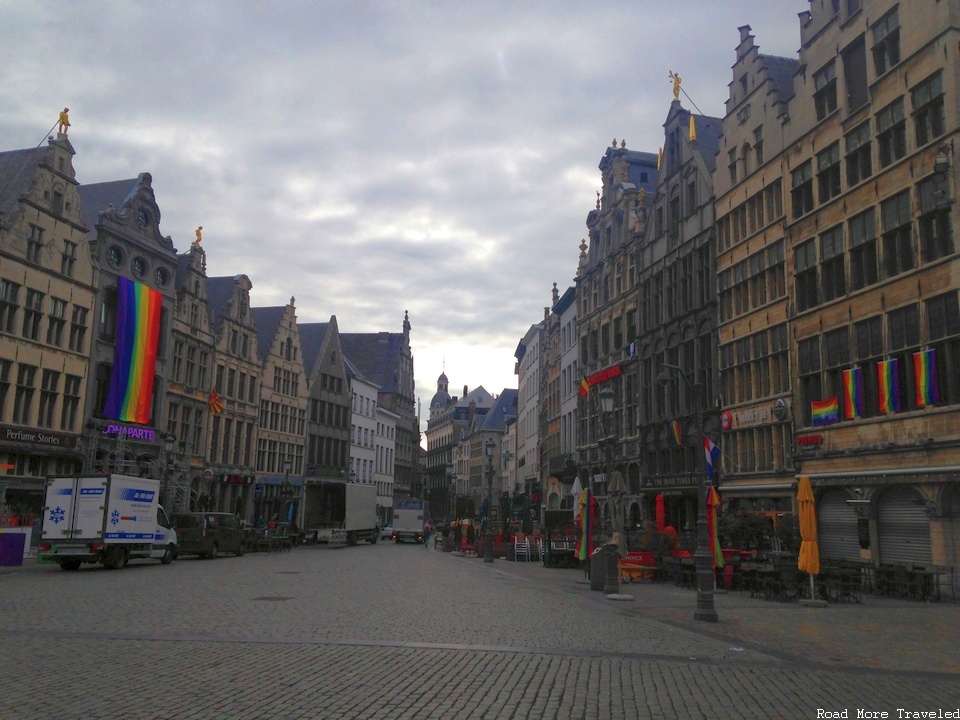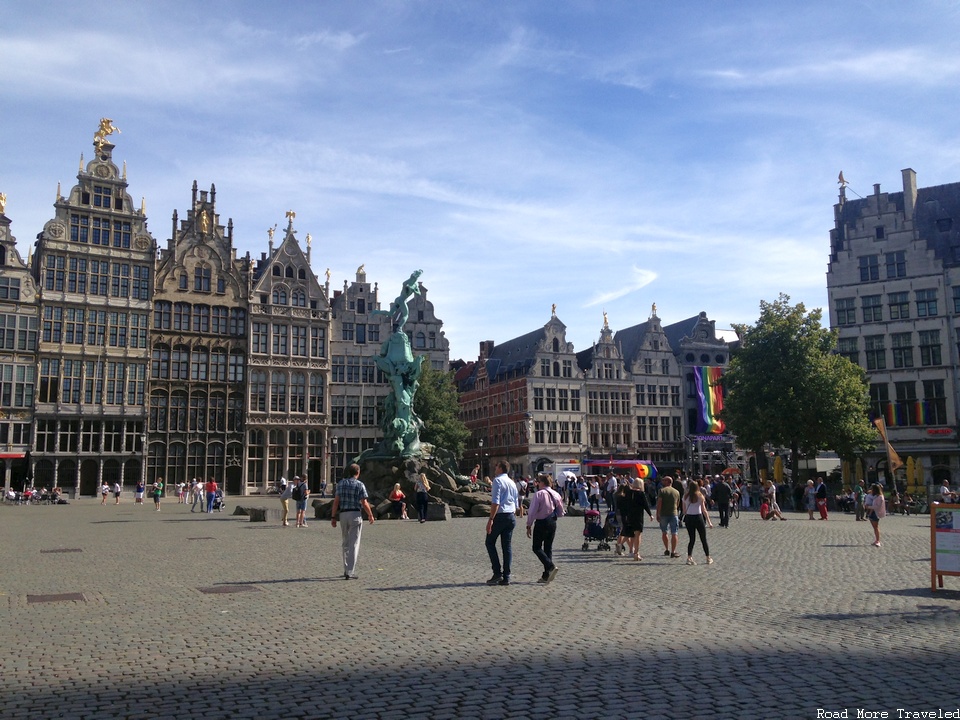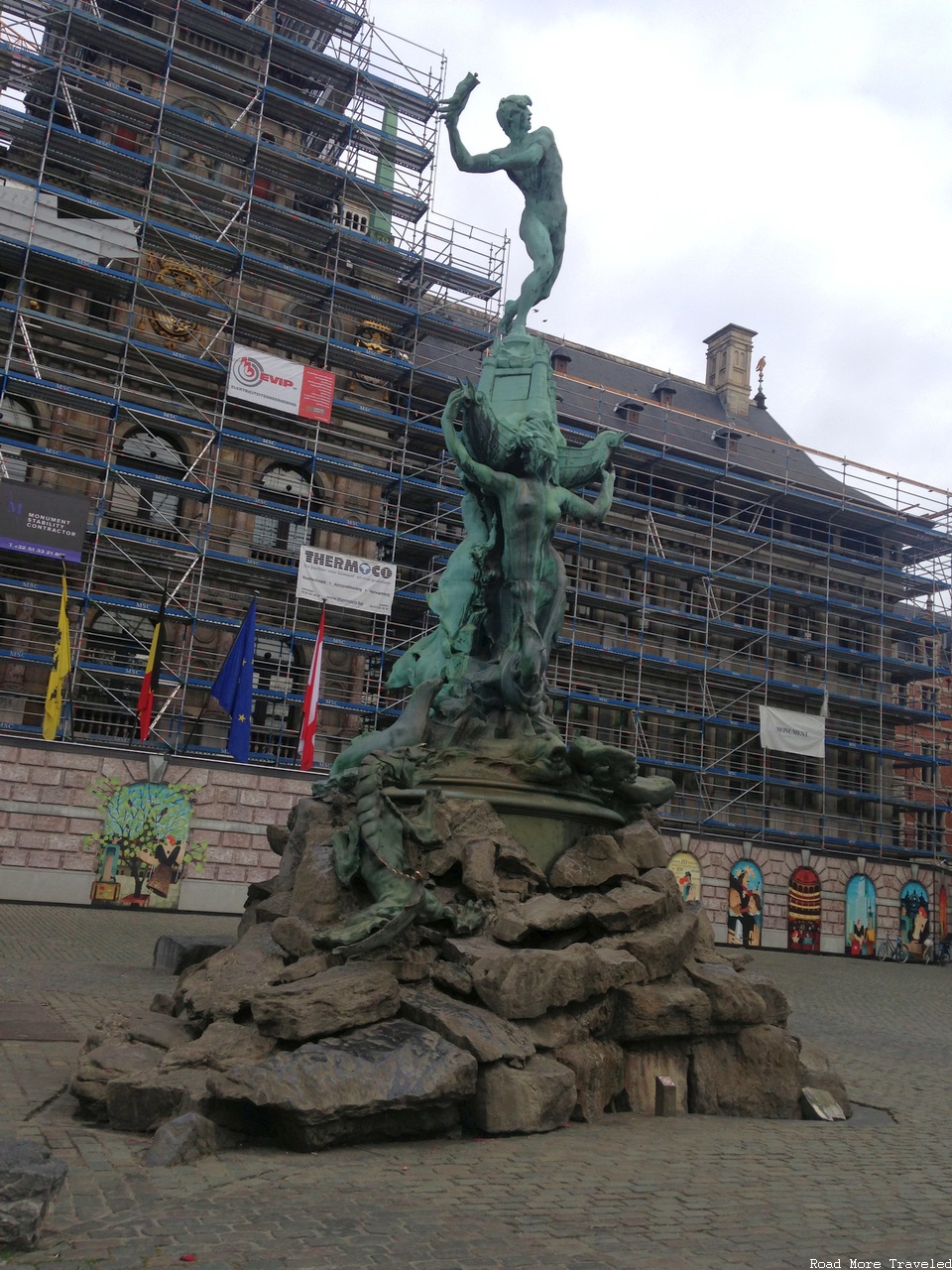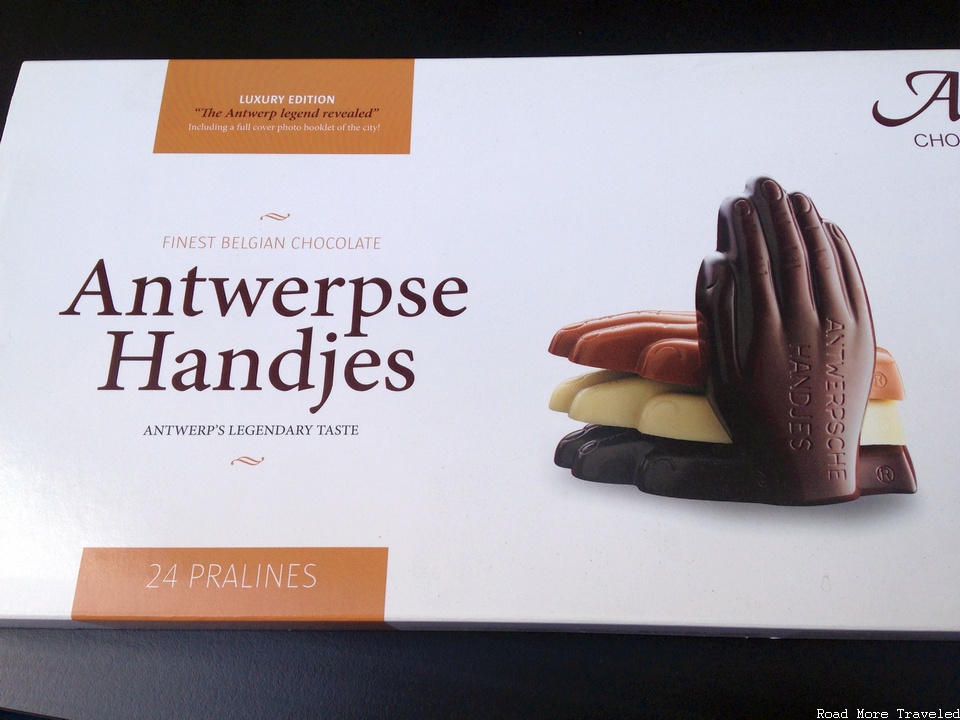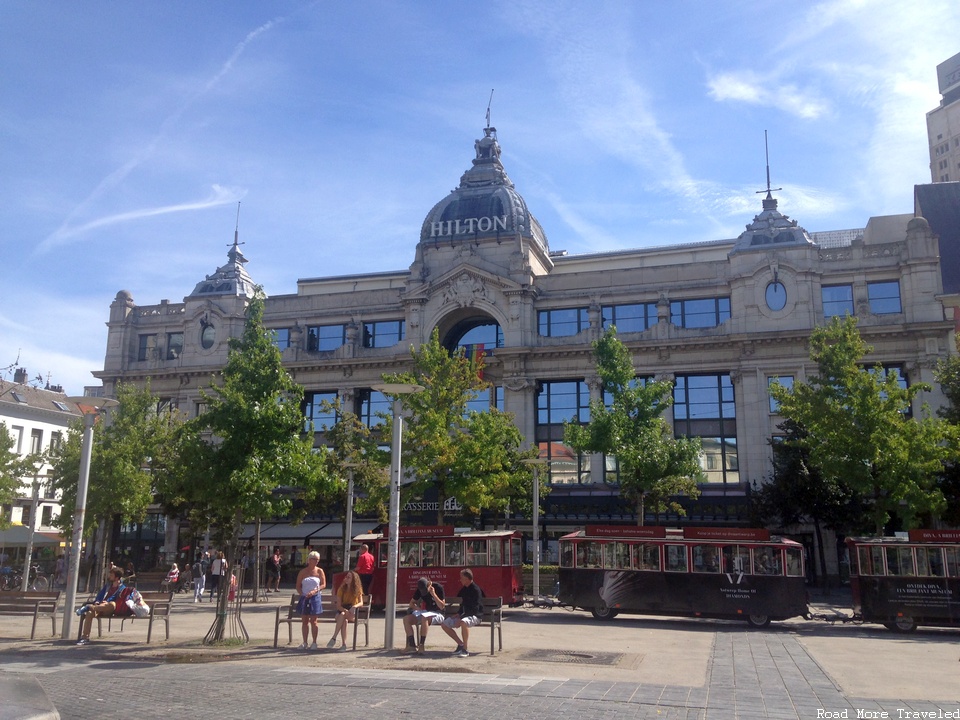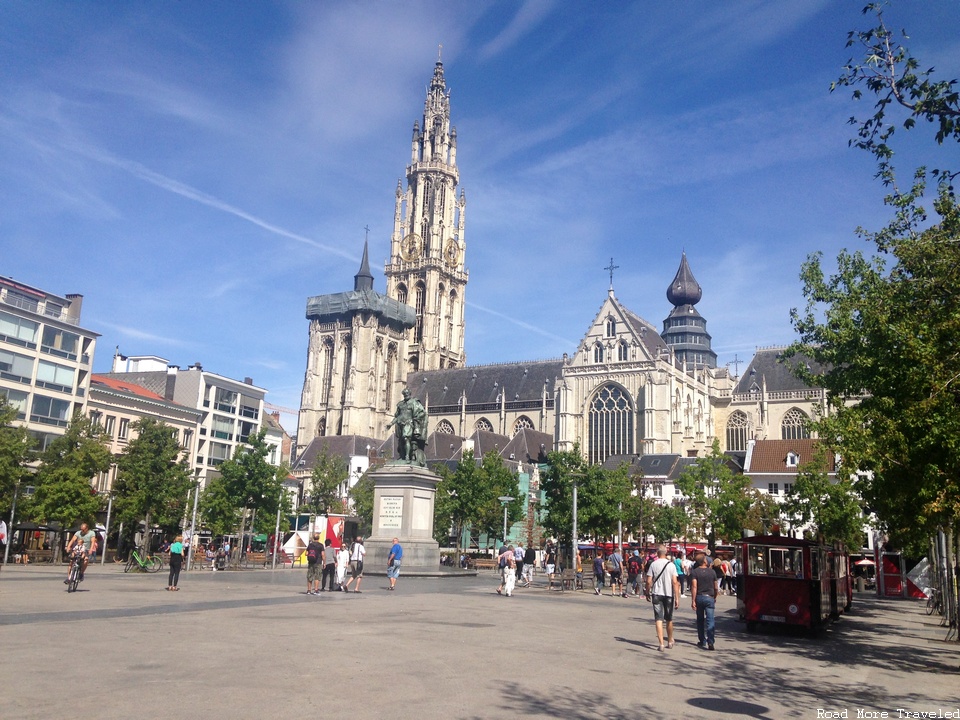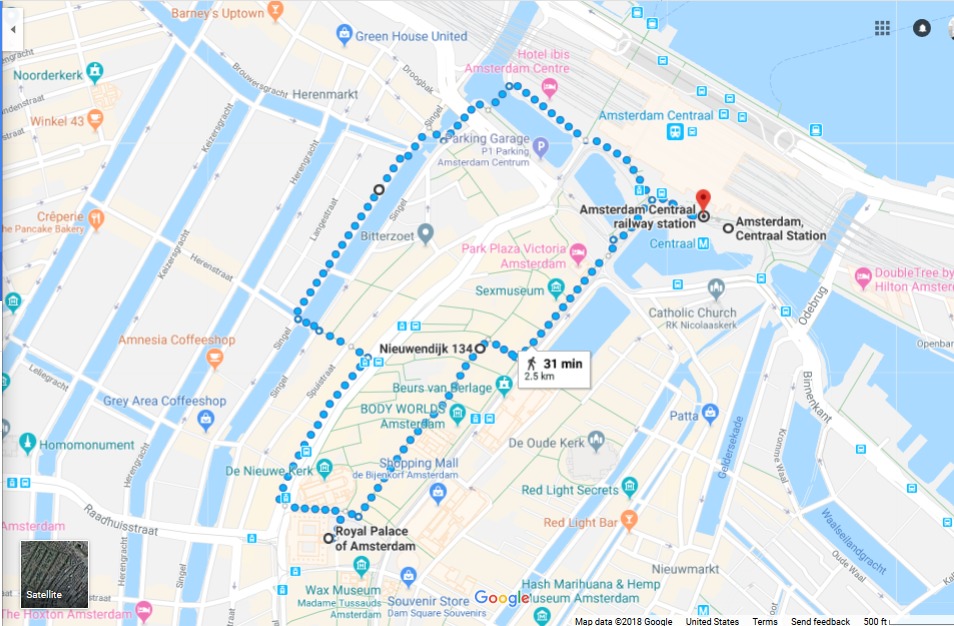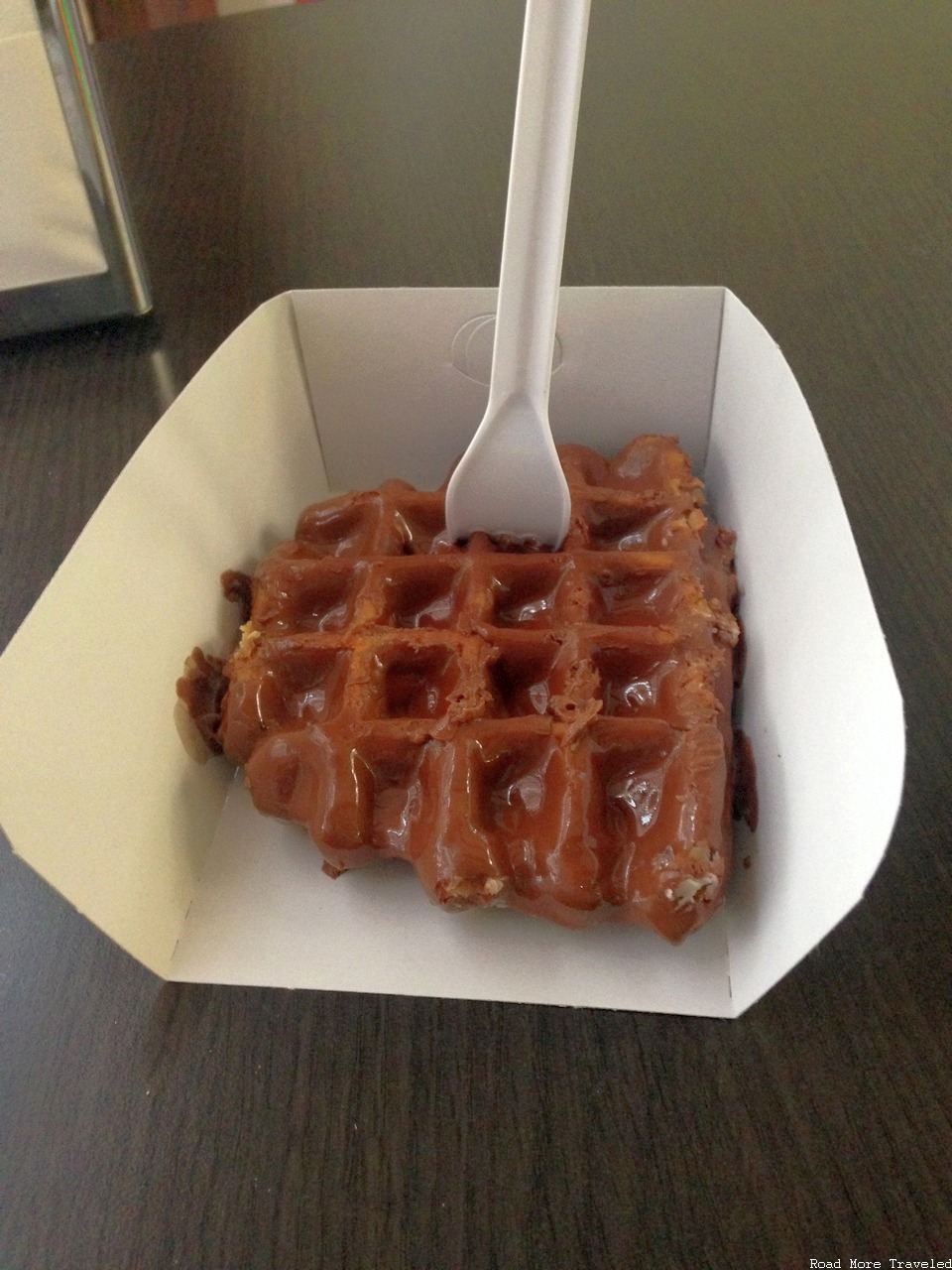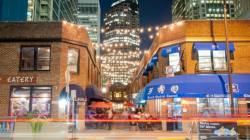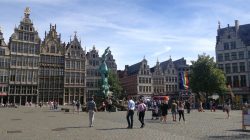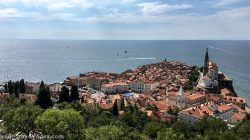Though my quick trip left me only one day to explore, I aimed to make the most of it. My flight from Detroit arrived at 6 am, giving me the entire day to do something. I’ve visited Amsterdam before, so I decided to start with a short trip to Antwerp. As an added bonus, crossing into Belgium marked country number 48 off my list.
Note: this post is part of my trip report series about my quick weekend trip to Belgium. Click here for the trip report index and introductory post.
Getting to Antwerp from Schiphol
I come from a state where it literally takes an entire day just to get to New Mexico. So, it always amazes me how easy it is to cross from country to country in the EU. Schiphol lies just 75 miles (120 kilometers) from the Belgium border, and a further 25 miles to Antwerp. The easiest way to reach Antwerp is by train. Conveniently, the station is directly attached to Schiphol Airport. After clearing passport control, look for the sign for Departures 3/Arrivals 3-4. This takes you directly to the Schiphol train station. If you want to store your bags, Schiphol offers a “left luggage” service, located between Arrivals 1 and 2. The cost is €6 per day for hand luggage, and €9 for regular bags.
You can buy tickets for either the Thalys (high-speed) or local trains from automated kiosks. Beware, the machines require a chip and PIN card, so most US-issued cards won’t work. There is a customer service desk which can process your transaction. Or you can purchase tickets online in advance, which may provide discounts off the walk-up price. I found “Trainline” easy to use, and they charge no booking fees. Compare that to buying directly from Thalys, which does charge a €5 booking fee.
Anyway, I decided to book online, and paid €45 for the Thalys train in “Comfort Class” for the 7:34 am departure. On this early departure, Comfort cost just €5 more than a standard ticket, and €18 more than second class on the local trains. So what does “Comfort Class” get you over “Standard”. Not much, really – basically more legroom and a 1-2 seat configuration instead of 2-2. Comfort Class seats also include a power port; bring an adapter as they are Euro-standard. All Thalys cars, regardless of class, include free WiFi, which was reasonably fast.
Comfort Class often prices €5 or less over Standard in advance, so you might as well buy up, I guess. I’ll talk about the value proposition over the local trains later. Anyway, just 58 minutes after leaving Schiphol, our train pulled in to Antwerpen Centraal.
Exploring Antwerp
You might say I have a borderline obsession with old European cities, especially the architecture. In Antwerp, you don’t have to go very far to find beautiful old buildings. Antwerpen Centraal actually isn’t that old, dating to 1905. But it is absolutely stunning, inside and out, and one of the most recognizable buildings in Antwerp.
From here, I headed in the general direction of the Historic Centrum, about a mile to the west.
Along the way, you pass through Antwerp’s commercial district. At 8 am on a Sunday, you have the city almost entirely to yourself. The only problem? This part of the city is full of construction, making picture taking difficult.
As you head deeper into the city, the streets narrow, and you can see the first glimpses of Flemish architecture.
The magnificent Cathedral of Our Lady also begins looming large in front of you.
The Historic Centrum and Grote Markt
At last, about 20-25 minutes after leaving the station, I reached the Centrum. I found myself in the Grote Markt, which literally translates to “Market Square”, a common feature in Flemish cities. Duke Henry I of Brabant donated the land to the city in 1220, though the actual square predates even that. The city then held annual markets here, where English merchants traded with both locals and travelers alike.
I must say, this square truly “WOW”ed me with its beauty. A few things especially stand out. Surrounding the Grote Markt are numerous, elaborate “guildhalls” built in the 16th century. The city’s trade guilds built these to use as meeting places, and often used especially ornate designs to show off their status. Though the Flemish Renaissance architecture is original, the sculptures you see were added in the 19th century.
Also located here is Antwerp City Hall, along with the Brabo Fountain out front. Unfortunately, city hall is currently under renovation, but you can still see the fountain.
Unveiled in 1887, the sculpture represents the (disputed) legend underlying the city’s name. According to this legend, the giant Druon Antigoon demanded that all ship captains passing through pay a toll. He then cut off a hand of any that refused. Later, a captain of the Roman army, Brabo, refused to pay and challenged the giant to a duel. The victorious Brabo then cut off the giant’s hand and launched it into the river. Thus came Antwerp’s name – a corruption of the Flemish words “hant” and “werpen”, meaning “launch hand”. Most historians dismiss this naming origin, though the city certainly milks it for what it’s worth, as I show later.
What really stands out, though, is the Cathedral of Our Lady. Construction on the Gothic masterpiece began in 1352, and progressed for 169 years. Like many medieval European cathedrals, it technically remains unfinished even today. Emperor Charles V planned a massive expansion in the 1530s, which would triple the size of the structure. That project was never completed following a fire in 1533. Nevertheless, the 405-foot tall spire long stood as the tallest structure in the Low Countries.
Just west of the Grote Markt, towards the river, is a quaint medieval residential quarter. You can walk through a maze of narrow alleys between old looking apartment houses. These quarters housed Antwerp’s poorest residents, with living conditions a stark contrast to today’s quaint appearance. The city demolished the alleys, and replaced them with what you see now in the 20th century.
Waffles, Beer, and Ham and Cheese Sandwiches
By now, with the clock approaching 10 am, the city finally started waking up. So I sought out the real reason for traveling all the way to Belgium – waffles. Waffle Factory just opened, so I popped in for a Brussels waffle covered with Belgian chocolate.
I later discovered that Waffle Factory is a chain with stores throughout Belgium and France. But I still thought it was a tasty waffle. Made on the spot, crispy, and the delicious goodness of Belgian chocolate in every bite. Pricey, though, at €6.50 for the waffle and a cappuccino. They do have numerous varieties of waffles, even “lunch waffles”, so it’s a decent place to check out.
Speaking of chocolate, I made my next stop at a chocolate store to pick some up. Well, one kind of chocolate specifically; Antwerp’s famous “chocolate hands”. Yes, the city takes its legend so seriously, you can take home a chocolate version of the giant’s severed hand.
After a little more walking around, I stopped at a Grote Markt cafe for a quick lunch. I chose something simple, a croque monsieur sandwich and a Corsendonk dubbel kriek.
The sandwich was alright, though I expected a generous helping of bechamel slathered over the top. I guess that’s what you get for ordering a French sandwich on the Flemish side of Belgium. The beer, one of Antwerp’s hometown brews, really hit the spot, though. I can’t really complain for €11.
The Groenplaats
After lunch, I first made a photo stop at Groenplaats. The square has an, ummm, rather morbid history. Until the 18th century, Groenplaats served as Antwerp’s main cemetery. At that time, Austrian Emperor Joseph II converted it into a square. Over time, the square grew dilapidated, but a redevelopment project in the 1990s improved it to its current state. Today, it’s a cafe-lined square, with a Hilton hotel on one side in a renovated 1920s building. If you plan on staying in Antwerp, it’s a good location.
The square also features a sculpture of Antwerp’s most famous citizen, Peter Paul Rubens, added in 1840.
And last but not least, enjoy one last view of the cathedral before leaving.
Rubenshuis
My last stop in Antwerp might have been the best – Rubenshuis, the home and workshop of Flemish artist Peter Paul Rubens. Rubens built this stunning Italian-style palazzo in 1610 with the fortune he amassed from his paintings. He not only used it as a family residence, but as his primary workshop. After changing hands numerous times, it became a museum dedicated to Rubens’ work in 1946.
The museum contains many masterpieces by Rubens and his disciples from the Baroque period. Its greatest work is Rubens’ self-portrait. I tried to take several photos, but unfortunately they didn’t come out. Below is a sampling of some of the more important works currently on display.

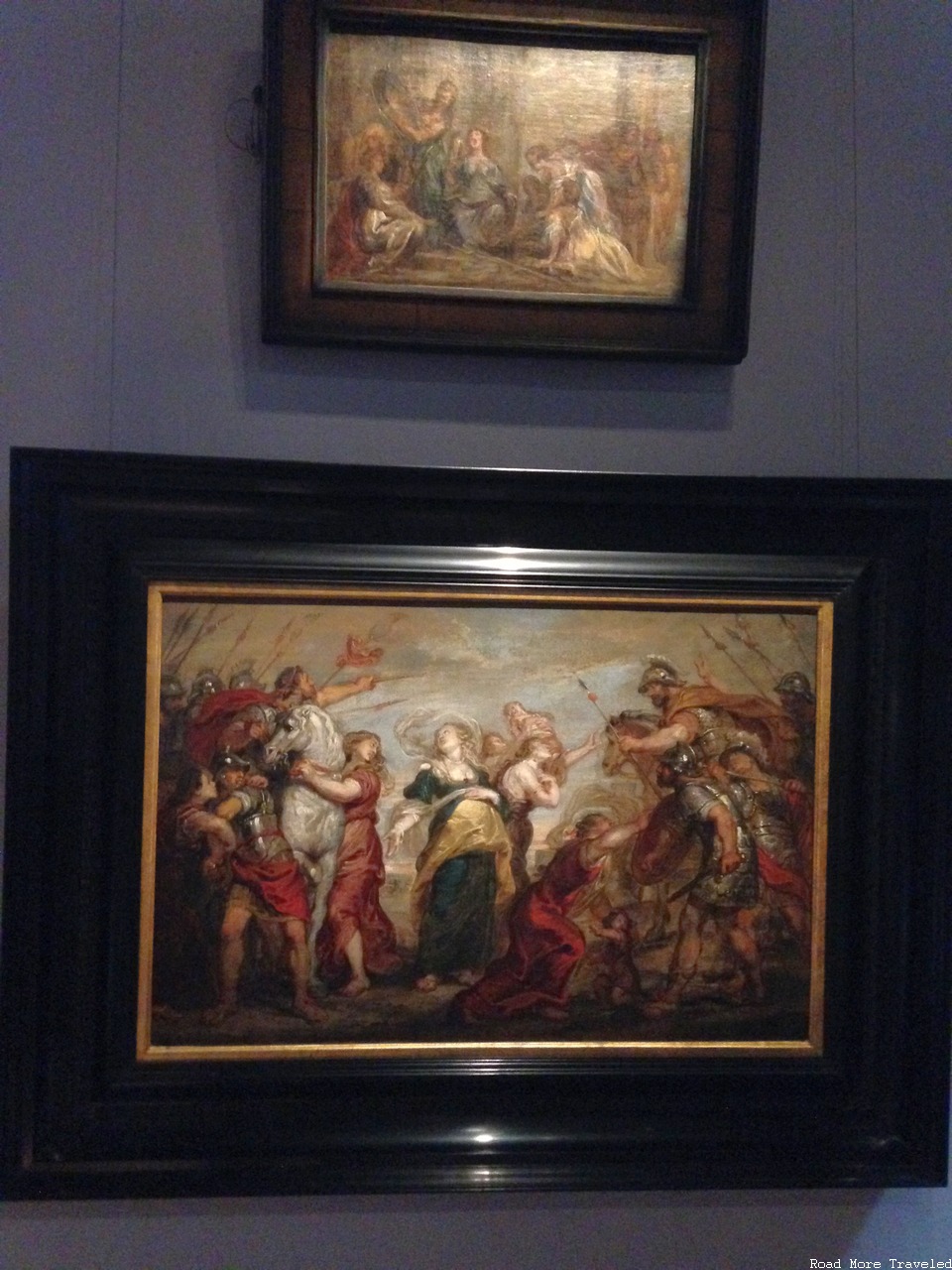


The museum also has replicas of the home’s original rooms, providing visitors a glimpse into the typical life of a wealthy Flemish citizen of the period.
As fantastic as the inside is, make sure to make some time to explore the restored Renaissance garden. It’s a beautiful, relaxing place to pass the time, especially on a warm summer day. It’s like a little slice of Italy dropped in to the middle of Flanders.
Even if you don’t care much for art, I highly recommend a visit to Rubenshuis if you visit Antwerp. Understanding the life of its most famous citizen is a great way to know the city as a whole. Admission is €10 for adults, €8 for students, and free for children under 12.
The Cheap Train to Amsterdam
After my visit to Rubenshuis, I headed back to Antwerpen Centraal to catch the train back to Amsterdam. This time, I took a regular intercity train back to Schiphol. So what’s the difference between the intercity and Thalys trains? Not much if you’re traveling in Standard or 2nd Class. You get the same 2-2 seating, and maybe a smidge less legroom.
The only real differences are about 35 additional minutes of travel time, no snack bar to buy food and drinks, and open seating in 2nd Class. The price difference can get substantial, though. Advance purchase weekend tickets on the intercity in 2nd Class cost €27 between Schiphol and Antwerp each way. Standard Class on the Thalys generally runs anywhere from €34 to €73. I suppose the time savings might be worth 5-10 euro, but personally I couldn’t justify much more than that.
Exploring Amsterdam
I arrived back at Schiphol just in time to check in to my hotel. After freshening up and checking in with the family back in Texas, I didn’t particularly feel like going out again. But I also knew if I stayed in the room, I’d fall asleep in no time. So, I forced myself to head into the city for a couple of hours. The great thing about Amsterdam is the easy access to the city from the airport. Local trains get you to Amsterdam Centraal in about 20 minutes, for a cost of €4.80 each way.
With only a couple of hours to spare, I just walked a short circle from Amsterdam Centraal, with a stop for dinner in between.
As beautiful as I found Antwerpen Centraal, Amsterdam Centraal is something else. The station opened in 1889, and today handles more than 162,000 passengers per day. And the exterior is ridiculously grand.
Immediately around the station are a couple of other things worth seeing. The first is the Basilica of Saint Nicholas, across one of the canals from the station. The church dates to 1887, with a striking, mixed Neo-Baroque and Neo-Renaissance façade. Even today, it is still Amsterdam’s primary Roman Catholic church.
This section of the city also has some very cool collections of Dutch houses along the canal.
Incidentally, if you wish to take a canal cruise, this is the place to catch one. Several tour operators launch their boats from docks along this canal.
From here, I headed west, taking in the bustle of the narrow city streets. A pleasant Sunday evening definitely brings the tourists and locals out in force.
I then spent a little time walking along one of the canals. Unlike the streets, the canals are surprisingly quiet and peaceful. In some ways, the canals remind me of a miniature version of Venice, right down to the quaint bridges.
At this point, I really needed a snack, so I headed back onto the city streets. I wanted a stroopwafel, but surprisingly, I couldn’t readily find a store or vendor selling them. So I ended up “settling” for a Nutella waffle instead.
Bakeries in this part of the city clearly charge a tourist tax; this little waffle set me back €4. But boy, was it ever tasty…
My snack fix satiated, I continued my walking tour heading south. This brought me to Magna Plaza. Completed in 1899, the building originally served as Amsterdam’s main post office. Since 1992, it has been a large shopping mall. And a site for tourists to gawk at, of course.
Next up was the Koninklijk Paleis (Royal Palace), one of three palaces used by the Dutch monarch. The palace dates to the Dutch Golden Age, completed in 1655, and was first used as a city hall. Its design is loosely based on Antwerp’s Town Hall in the Grote Markt. It became a royal palace in 1806, except for a brief break from 1810-1813 when the Netherlands fell under French rule. The building sits on the west side of Dam Square, making it both the official and unofficial center of Amsterdam.
Next to the Royal Palace is another fantastic building, Niuewe Kerk. Nieuwe Kerk was completed in 1408 and used as a church. The original structure nearly burned to the ground, with the current Gothic building taking its place in 1645. Though the building is still owned by the Dutch Protestant Church, it is no longer used for church services. Instead, it houses various rotating exhibitions on art, culture, photography, etc.
Next, I set off in search of dinner, eventually finding a spot advertising Dutch pancakes. Having already satisfied my sweet tooth, I went with something savory this time, ordering a ham and cheese pancake with fresh squeezed orange juice.
What the Dutch call “pancakes” are really crepes. Sometimes they’re sweet (i.e. Nutella), sometimes they’re savory. This one was crispy, and sort of reminded me of a Tibbs Frankie, a popular member of the Indian street vendor scene. Like the Frankie, this savory crepe was really addictive.
I returned to Amsterdam Centraal from here, but not before getting a laugh at this “coffee shop”. No, I did not go inside to sample the merchandise.
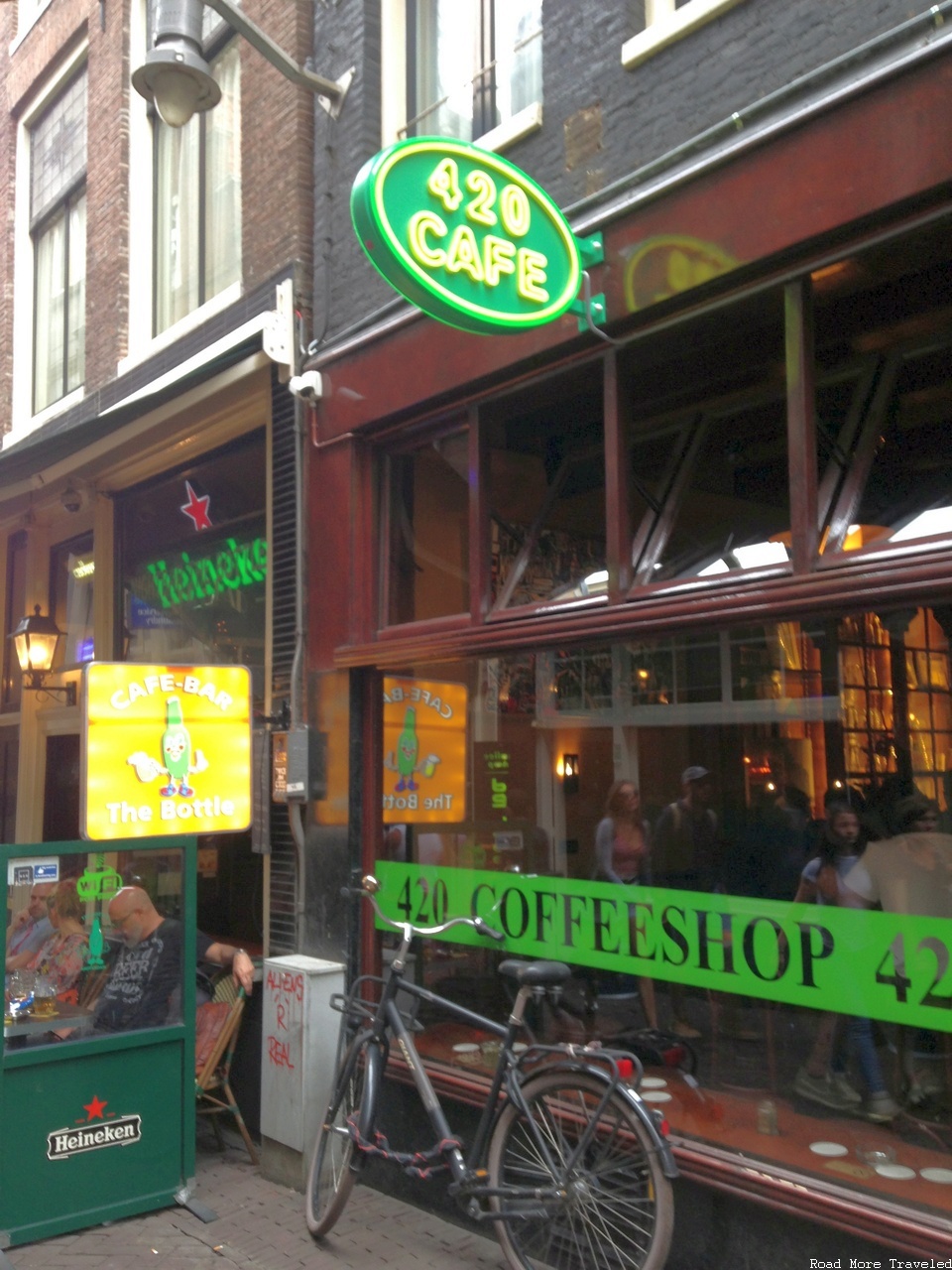
After all that walking, needless to say I slept well that night.
Final Thoughts
This was a LOT of combined walking, but staying active is my secret to combating jet lag. And it gave me the chance to explore one new city (Antwerp), and get reacquainted with one I’ve seen before (Amsterdam). If you have a long or all-day layover in Amsterdam, either one makes a great place to kill some time outside the airport.

